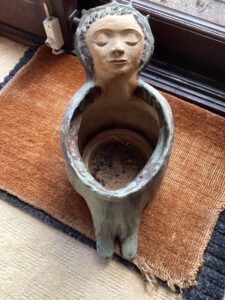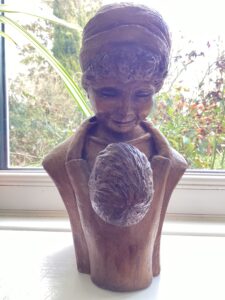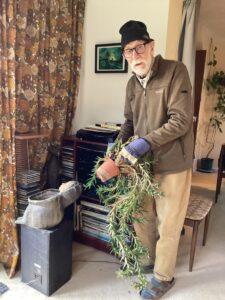Alan was born in South Yorkshire and talks about how he and his wife ended up in Norwich and their involvement with Wensum Lodge. Sadly Alan’s wife Marianne passed away in 2024.
Home and school in Sheffield
I’ll start in Sheffield, South Yorkshire where I was born in the 1930s. I grew up in an industrial suburb and we lived in a standard, northern, industrial, terraced house. There were three houses together in a yard and to get behind the houses there was what we called an entry. You went through a gap and then at the back there were three small gardens and the outside toilets. The houses had no inside toilet or bathroom. They were very, very primitive and that was where I grew up. Now it seems very primitive, but of course, everybody was in the same boat. We thought it was normal.
My father worked in the steel works. He was what was called a rolling mill clerk, and he did the paperwork behind producing different sizes of steel rod, but he had had no formal education himself. He’d left school when he was 12 and his father got him a job in a garden, a nursery. Eventually he ended up in the steel works office.
King Ted’s
My father was very keen on education. I went to the local council school and then I passed the 11+ and in those days that led onto going to a grammar school.’ The better your marks in the 11+ were, the more chance you had of getting to the top boys’ grammar school in Sheffield which was called King Edward VII Grammar School or ‘King Ted’s’ as it was referred to. So, I managed to get there. Of course the majority of the boys at the school came from what we called the posh end of Sheffield.’ Their parents were mostly professional people but we very quickly got together, it didn’t seem to me to be a problem that our backgrounds were different and we made friends.’
Then eventually, after two years, I took what was called the School Certificate, the precursor of ‘O’ levels. I passed and then came the problem of what to do next. My father had always thought that after I got to the school certificate stage, I would leave school and get a job in an office somewhere or train in a bank, something like that. But at the school I went to, the ethos was that you went to university and to get to university you had to take, what then became ‘A’ levels, and’ stay in the sixth form.
My father said, ‘well, we can’t afford for you to stay in the sixth form really’ because I had two siblings.’ He said, ‘you’ll have to leave and get a job.’ But fortunately, Sheffield City Council, which was socialist, gave grants to boys like me at 16 to enable them to stay on in the sixth form. It was basically a maintenance grant and also paid for your clothing. So, I managed to get one, and I stayed in the sixth form for three years.’ But another problem was that my house did not have a suitable place for me to study. I didn’t have my own bedroom and there was nowhere in the winter for me to sit and do my homework. So, the whole time I was in the sixth form in the winter I stayed at school, had my tea at school for three days a week and then I went into Sheffield Public Library to do my homework. That meant I could study and get reasonable ‘A’ levels.
University
There was a tradition of going to Oxbridge at the school I went to. In fact the school’s success was governed by the number of scholarships it got to Oxford and Cambridge every year. But a school friend had decided he wanted to be a civil engineer and he didn’t want to go to Oxbridge. He wanted to go to Imperial College in London and he knew that I wanted to study chemistry, so he said to me ‘why don’t you apply to Imperial College and do a chemistry degree there and we’ll go to London together.’ So, I said, ‘yeah ok’ and, to cut a long story short, we both managed to get into Imperial College. He studied engineering, and I studied chemistry.’
But then when I was doing my first degree there, my BSc, a similar problem turned up that I had when I was doing ‘O’ levels at school, what to do next.’ A lot of the people were going on to do a Ph.D. In those days there was national service and if you were studying for a’ Ph.D. then you didn’t have to go into the army so I decided I’d do a Ph.D. I put it off for three years and then I did my Ph.D. in a medical school in London and specialised in biochemistry.
The John Innes Horticultural Institute
Then for two years from 1959 to 1961 I studied in Denmark in Copenhagen. People did what was called a post doc. which was another standard thing people did. So I went to Copenhagen and then with that experience I came back to London and ended up getting a job at the John Innes Horticultural Institute, which was a research institute in Hertford about 20 miles north of London.
There, I very quickly met and got to know my wife, Marianne. She had grown up in Switzerland and did her early education there. She then became a laboratory technician and managed to get a job in Oxford in the Sir William Dunn School of Pathology. While she was there, the man she worked for, Dr Henry Harris, became the Head of the Cell Biology Department at the John Innes Institute and so she moved from Oxford to Hertford. I ended up in the same building as her and she helped me settle into a new building and a new laboratory.’ In the process, we got friendly and in 1962 we got to know each other. She had managed to get one of the first mini cars, and so from Hertford, we could drive into London in the evening and go to the cinema, to a play or to a concert because it was only 20 miles away and in those days you could drive into London and back and park outside.
Married
So, as I say, we got friendly and at the end of the year we decided to get married and she took me over to Switzerland to meet her family and they were incredibly welcoming. She’d got three older sisters who all had children, ten children between them. One of the sisters put on an engagement party with all the family and they were very welcoming and so we got off to a good start.
Moving to Norwich
So then, as far as my career was concerned, I decided I wanted to teach in a university and as there were several new universities at that time, it was relatively easy to get a job. I managed to get a post at UEA here in Norwich and so in 1965, we moved to Norwich. First of all we lived in Cringleford and then we realised Cringleford was a non place. It didn’t have a pub or a shop of any kind and so we moved into the city where I’m living now.
After we got married, Marianne decided that she didn’t want to continue being a laboratory assistant, she wanted to do something more interesting. So, I said, ‘well you know, I’m a university lecturer, I should earn enough money to keep us both.’ You don’t have to work, and you can do things that you’re interested in.’ So she did quite a bit of voluntary work including being a volunteer at the Priscilla Bacon Lodge, which is for people who need palliative care.
Classes at Wensum Lodge
She also did interesting things for herself and it was then she discovered Wensum Lodge and the thing that caught her imagination was the clay modelling class.’ The man who was her teacher, I can still see him,’ I’ve forgotten his name, but the class obviously struck a chord with her. She got so keen on making these models that after our children left home, we converted one of the bedrooms into a workshop where she could make the models. The only thing she couldn’t do was to fire them, but that didn’t matter because they had a kiln at the class at Wensum Lodge. They had firing facilities and so she spent a lot of time doing that.
Another thing she did at Wensum Lodge which was very interesting, was she went to’ piano lessons for accompanists. Now that was handy because our daughter Sandy or Alex, took up playing the cello at an early age and she was very good.’ So, Marianne, who had first learnt piano in Switzerland, with the training at Wensum Lodge, managed to accompany Sandy in all her grades and get her through her music education. It was largely due to Wensum Lodge, I suspect, and it furthered Marianne’s main interests which were music and the clay modelling. Our daughter got good grades and then when she went into the sixth form at school, she said,’I’d like to do music ‘A’ level’ and so I said ‘OK, but you must do maths and physics as well.’ I had assumed she would be a scientist but of course she wanted other things.
So, she went to the Royal Academy and that turned out to be a real success. There were very few students in a year and they didn’t have any lectures. They were set work every two weeks, having to come up with an essay, researching it in the library and writing it up. At the end of the year for the B.Mus (Bachelor of Music) qualification they had to do a recital and had to learn pieces for that. Then when they finished the B.Mus course she stayed on and did a M.Mus (Master of Music) because the City Council, or the Norfolk County Council gave music students an extra year’s grant.
Eventually when she came to look around to find what to do with this music qualification, she didn’t want to teach one-to-one, and the other thing she didn’t want to do was play in an orchestra.’ She’d got friends in an orchestra and she realised what a hard life it was. A friend of mine, who I had been at university with, was staying with us one weekend and he suggested that she go into computers and computer science because there was a shortage of people doing that.’ She said, ‘they won’t take me will they, because I’ve got a music degree’. He said, ‘you could do a one-year conversion course, it doesn’t matter what degree you’ve got, they’ll take you.’’ So, she did a one- year conversion course in computer science and during that course she was offered a Ph.D place at University College. She’s now working in Glasgow in the Computer Science Department, but before that she was at Salford for a while and at Durham. She’s now 60 and so she’s actually taken to this new career. The downside is because of using the keyboard she’s got what’s called ‘repetitive strain injury’ and’ can’t play cello anymore. Anyway, we’ve still got the cello. It’s worth a few bob. But that’s what she did and so she’s very highly qualified.
My time at Wensum Lodge
I got to Wensum Lodge largely through my part-time job. I became a tutor at the Open University and one of the classes were on a Saturday morning at Wensum Lodge. This was a lovely place to teach tutorials because half way through a lecture, tutorial or seminar, a man would appear with a notepad and he would ask us what we wanted for our coffee or tea break. Then of course when everything was over, we would go down to Jurnet’s Bar and have a drink and have lunch there if we wanted to. So, we did go to other classes at Wensum Lodge, but I can’t remember many details about them. So, it was definitely a place that held a great interest for Marianne and for both of us.
Lovely memories of Marianne and her pots
Then I was shown a photograph from the Archive of Marianne making a very large pot. It must have been more than 30 years ago I think and there she was making this pot that’s still in our house. So now we have a photo of it. It was a bit disguised with a potted plant. So that’s some of the stories of our involvement really with Wensum Lodge.

Sadly Marianne had dementia for some three years. I looked after her at home for three years and of course before that she’d stopped going to classes. I can’t remember the last time she went to the pottery classes. She kept on going to concerts for a long time but then eventually it just took its toll, and she had to go into a home and then she died, almost a year ago now in March.
When my wife made pottery, the subject matter could be family, cats or other animals. We went away on holiday quite often after I retired and if we went somewhere and she saw a pot or a statue in the window, she’d take a photograph of it and then make one when we came back. We went to Prague and there’s a statue outside Prague of a character in one of Mozart’s operas. Il Commendatore, I think he’s called, and anyway we’ve got a small one of him and we’ve also got Beethoven of course.’ We had to have a Beethoven over the piano!
I still see Marianne’s former teacher because we both go to concerts at the Norwich Chamber Music Club, and I usually say hello to him and his wife. Marianne did a sculpture of his head and once when I saw him, I said, ‘oh yes I’ve got a statue of your head, we use it to keep the door open.’ Which wasn’t true actually.
Marianne was very talented compared to me. I’ve always been very non arty. I’ve never painted. The only art which I’ve taken to really is music, singing in a choir but I’ve not done any graphic art.
I’ve got these memories and I’ve got children and two grandsons. Marianne was very good at capturing faces in her models. I guess, they’ve been around all the time. It’s a bit like the story of the man who set up the Sainsbury Centre. Bob and Lisa Sainsbury collected art that they liked, and they had it all in the living room of their house in London. Their son David, who paid the money for the Sainsbury Centre, he said, when he was at school, he was invited round to his friends for tea, and he wondered where was the art. Nobody else seemed to have any, no pictures, no statues. That’s why they call the main exhibition space at the Sainsbury Centre, the living space, they’re all together in one place. I remember when it was built. I was in the biology department opposite and it was lovely because if you wanted to, you could get away from the science, just nip in there, sit down amongst the art and look at it. That was what it was intended for. I could turn my house into an exhibition. Get somebody to do some paintings.
Lasting memories of Wensum Lodge
I went to some courses there and I used it as part of my teaching job and it was just a nice place to go and plenty there. Regarding the social side, there was Jurnet’s Bar and there was a separate restaurant. must admit I hadn’t realised that it was shut down. It’s in a lovely spot by the river.
Alan Coddington (b. 1934) talking to WISEArchive on 6th February 2025 in Norwich. © 2025 WISEArchive. All Rights Reserved.








